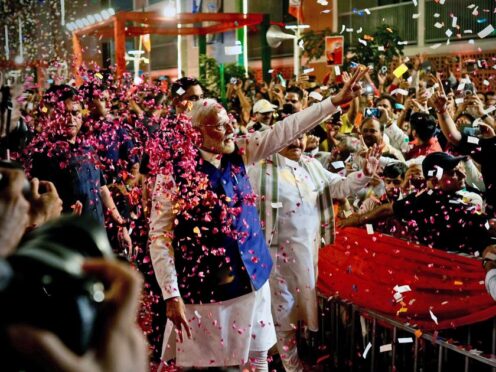Prime Minister Narendra Modi’s National Democratic Alliance coalition has won a majority in parliament, according to official results from India’s Election Commission.
The commission said the NDA won 285 seats and was leading in one race yet to be called, more than the 272 seats needed to secure a majority but far fewer than had been expected.
That was largely due to Mr Modi’s own Bharatiya Janata Party winning more than 60 seats fewer than the record 303 it won in the 2019 election.
More than 640 million votes were cast in the marathon election held over six weeks in the world’s largest democratic exercise.
Speaking from @BJP4India HQ. https://t.co/x2neIsArbi
— Narendra Modi (@narendramodi) June 4, 2024
“Today’s victory is the victory of the world’s largest democracy,” Mr Modi told the crowd at his party’s headquarters, saying Indian voters had “shown immense faith” both in his party and his National Democratic Alliance coalition.
Mr Modi’s win was only the second time an Indian leader has retained power for a third term after Jawaharlal Nehru, the country’s first prime minister.
But also, for the first time since his Hindu nationalist Bharatiya Janata Party swept to power in 2014, it did not secure a majority on its own.
That means Mr Modi will need the support of other parties in his coalition, a stunning blow for the 73-year-old, who had hoped for a landslide victory.
The party may now be “heavily dependent on the goodwill of its allies, which makes them critical players who we can expect will extract their pound of flesh, both in terms of policymaking as well as government formation”, said Milan Vaishnav, director of the South Asia Programme at the Carnegie Endowment for International Peace.

In the face of the surprising drop in the BJP’s support, challengers claimed they had also won a victory of sorts, with the main opposition Congress party saying the election had been a “moral and political loss” for Mr Modi.
“This is public’s victory and a win for democracy,” Congress party President Mallikarjun Kharge told reporters.
Despite the setback, Mr Modi pledged to make good on his election promise to turn India’s economy into the world’s third biggest, from its current fifth place, and not shirk with pushing forward with his agenda.
He said he would advance India’s defence production, boost jobs for young people, raise exports and help farmers, among other things.
“This country will see a new chapter of big decisions. This is Modi’s guarantee,” he said, speaking in the third person.
Many of the Hindu nationalist policies he has instituted over the last 10 years will also remain locked in place.

Before he came to power, India had coalition governments for 30 years.
The opposition India coalition won 225 seats and was leading in five others yet to be called.
Congratulations for Mr Modi from leaders of regional countries including neighbouring Nepal and Bhutan flowed in, while the White House commended India for its “vibrant democratic process.”
In his 10 years in power, Mr Modi has transformed India’s political landscape, bringing Hindu nationalism, once a fringe ideology in India, into the mainstream while leaving the country deeply divided.
His supporters see him as a self-made, strong leader who has improved India’s standing in the world.
His critics and opponents say his Hindu-first politics have bred intolerance while the economy, one of the world’s fastest-growing, has become more unequal.
For Payal, a resident of the northern city of Lucknow who uses only one name, the election was about the economy and India’s vast number of people living in poverty.
“People are suffering, there are no jobs, people are in such a state that their children are compelled to make and sell tea on the roadside,” Payal said. “This is a big deal for us. If we don’t wake up now, when will we?”

Rahul Gandhi, the main face of the opposition Congress party, said he saw the election numbers as a message from the people.
“The poorest of this country have defended the constitution of India,” he told a news conference.
Mr Modi’s popularity has outstripped that of his party’s during his first two terms in office, and he turned the parliamentary election into one that more resembled a presidential-style campaign, with the BJP relying on the leader’s brand.
“Modi was not just the prime campaigner, but the sole campaigner of this election,” said Yamini Aiyar, a public policy scholar.
Under Modi’s government, critics say India’s democracy has come under increasing strain with strong-arm tactics used to subdue political opponents, squeeze independent media and quash dissent.
The government has rejected such accusations and says democracy is flourishing.
Economic discontent has also simmered under Modi. While stock markets have reached record-highs, youth unemployment has soared, with only a small portion of Indians benefiting from the boom.
But the election campaign turned increasingly shrill, as Mr Modi ramped up polarizing rhetoric that targeted Muslims, who make up 14% of the population, a tactic seen to energise his core Hindu majority voters.
